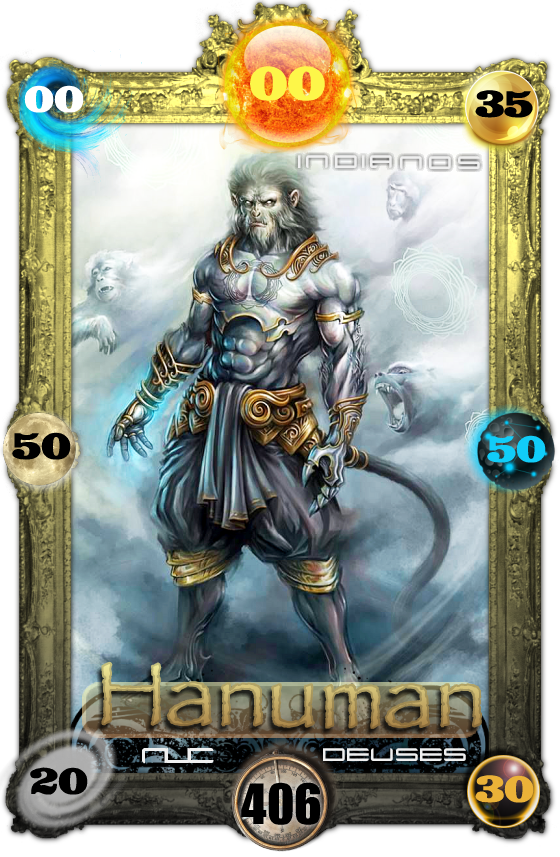Hanuman
Gods - Indiana Mythology
Card 406
-
The Gods
The gods are very powerful.
"And the time will come when the gods will hear the cry of their priests."
(the gods do not need books to teach them how to handle magic, for they created them)The Gods influence battles, fighting the enemy of those who have their favor.
Important: The gods fight a battle and withdraw from the war, until someone conquers their favor again.
To approach a god and fight directly with him and his upgrades (weapon, mount, etc.), you first need to survive your powers.
Note: Gods are immune to many powers, only rare spells created directly against the gods, can reach them
* If two gods meet, the one who is defeated (gods can not die), withdraws from the battle. And the other continues to face the enemies of his favored.
Battle Area:
- Water = 00
- Earth = 50
- Heaven = 20
Attack and Defense
- Wisdom = 35
- Dexterity and Strength = 50
- Powers = 30
- Fire = 00
Game
Rules
Recurses
Characters
Hanuman
Gods - Indiana Mythology
Hanuman is a monkey god of Hinduism. The Ramayana reports that indeed Hanuman was an incarnation of the mighty God Shiva, who had manifested on Earth during the period of Rama, one of Vishnu's incarnations, to assist him in his tasks.
Hanumam manifested himself as a vanara (humanoid ape) and minister of the king of the vanaras, having been one of the great heroes of the epic described in the Ramayana. He was responsible for the discovery of Sita's captivity in Lanka, the burning of the city and the annihilation of several important raxasas of the Ravana tribe.
The Ramayana is not the only text of the Vedic literature mentioned by Hanuman. There is also the "Hanuman Chalisa" and the "Mahabharata".
According to these texts, Hanuman is the son of the Wind God (Vayu), and an avatar (incarnation) of Shiva whose task is to assist King Ramachandra to defeat the demon Ravana. Hanuman is also called Anjaneya, in allusion to Vanari Anjana, who is his mother.
When the Monkey King Sugriva is expelled from the kingdom of Kishkind by his brother Vali, Hanuman helps Sugriva to hide and eventually defeat Vali, with the help of Rama and Lakshmana.
In exchange for the help of the two princes Sugriva should help them to rescue Sita Devi, then prisoner of Ravana. But Sugriva forgets his promise, but Hanuman helps Lakshmana to convince him to fight alongside Rama.
In the war, Hanuman displays powers (sidhis), being able to fly and to change of size. In the course of the battle, Rama and Lakshmana are imprisoned by Ahiravana, an uncle of Ravana. To rescue them Hanuman faces the Raxasa, which can only be defeated if five bonfires are erased simultaneously. To achieve this, Hanuman assumes a five-headed form:
• Sri Hanuman, his normal monkey head.
• Sri Garuda, the eagle's head. Allusion to Vishnu's mount.
• Sri Varaha, the head of a boar. It represents the third incarnation of Vishnu.
• Sri Narasimha, the lion's head. It represents the fourth incarnation of Vishnu.
• Sri Hayagriva, the horse's head. It represents another avatar.
Another important moment in history is when Lakshmana is wounded in combat. To save him, Hanuman carries the mountain "Dronagiri" to the battlefield, so that the monkeys remove from it the herbs necessary to save Lakshmana.
Even after Rama dies, Hanuman remains on earth as an immortal. In "Mahabharata" he appears to test the humility of Bhima (the middle brother of Yuddhishtira and Arjuna), and eventually Krishna forces Hanuman to serve Arjuna in the war.
That is why Hanuman would be one of two people who would have heard the "Bhagavad-Gita" besides Arjuna (the other is Sanjaya). For the Hindus, Rama and Krishna are the Vishnu God incarnate at different times, so Hanuman represents the ideal devotee (Bhakta). It also symbolizes Tapas, (sacrifice), and Brahmacharya, (chastity).
In the Hindu community he is worshiped as the incarnation of Shiva, and revered for his devotion to Rama. In Hindu astrology it is said that meditation on the name or figure of Hanuman removes the evil brought by Shani (Saturn).
NUC Cards ® 2019
Reasoning and strategy.
An advanced game of underground strategy in generation.
